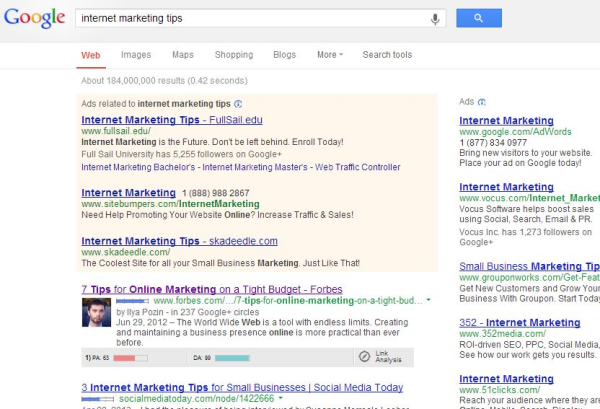 Last week, the head of Google’s web spam team, Matt Cutts, announced that the Panda algorithm is updated approximately every month, but it’s done slowly throughout the month, like a Google Dance. What the heck does this mean to you? Today’s internet marketing tips post explains.
Last week, the head of Google’s web spam team, Matt Cutts, announced that the Panda algorithm is updated approximately every month, but it’s done slowly throughout the month, like a Google Dance. What the heck does this mean to you? Today’s internet marketing tips post explains.
What is the Google Algorithm?
When you log on to the internet and type a word or phrase in the search bar, you get a page of results, right? For example, if I type in “internet marketing tips for small business” I get a list of websites all begging me to click on them. See below:

Google finds this list of websites by “crawling” the web using programs and formulas written by the intelligent people who work there. Then, Google goes about sorting and ranking the gazillions of web pages using the formula or “algorithm” based on over 200 different factors, in hopes that it provides you the most relevant results. Google keeps track of all these things in an index. We could write a whole internet marketing blog about how search works, but that’s enough for you to know for now to help understand the focus of this blog: the Panda Dance.
What is the Panda Update?
Back in February 2011, Google introduced a major update to its algorithm (that formula we just learned about above that is used to show relevant websites in search results) they named the “Panda Update.” (It was named after the guy who created it). The goal of the Panda Update was to return higher-quality sites near the top of search results or said another way, the update was meant to stop sites with poor quality content from appearing in top search results.
Google changes its algorithm regularly, but most changes are so subtle they aren’t really noticed. However, the Panda Update created quite an uproar in the internet marketing world because suddenly websites that were ranking well dropped in the search results, while other’s saw their websites increase in ranking. No one really understood why. This algorithm change was so significant that is caused some businesses to completely change their name and/or business model in order to rank well again.
A year after the initial Panda Update we've learned that Google targeted web pages whose content it deemed was not good enough or lacked substantial substance.

Panda is called an update because Google runs the filter periodically. Each time it rolls out a Panda Update, new and improved content escapes through the filter and poor content gets caught and that site is ranked lower. Quality content is just one of over 200 factors Google uses to rank pages, but it’s an important factor. Businesses that continue to provide good content as well as pay attention to the other factors – like keywording and linkbuilding just to name a couple – as part of their internet marketing strategy, will be just fine.
What is the Panda Dance?
This brings us to today, just over two years later and Google’s latest Panda Update. According to Search Engine Land, Google’s head of web search spam, Matt Cutts (a name you should know if you are in any part of the world of internet marketing!) announced that the Panda algorithm is updated roughly every month, but that it’s updated slowly throughout the month. This means that Google will pick a date to run the update then slowly push out the impact over 10 days or so. Google said it will continue to do this kind of rolling update and will stop announcing each time it does it.
Are you wondering why it’s called the Panda Dance? Back in the good ‘ole days of Google, Google would release monthly updates to its algorithm all the time, which would cause the rankings to “dance” on the search engine results page. Panda kinda does the same thing, but we are beginning to understand it better.
What does the Panda Update Penalize?
The major Panda Updates have been created to address the following, which negatively affects your SEO (Search Engine Optimization) strategy:
Un-Original Content – Web pages that have a lot of advertisements and links or low-quality content that has been purchased from “content farms.”
Identical Pages to Target a Specific Keyword – Creating duplicates of the same web page on your site, but using a different targeted keyword variation on each page. For example, using “toenail fungus laser treatment” on one page and “laser treatment for toenails” on another.
Ads Above the Fold – If there are too many ads above the fold on a web page, and the user has to scroll before reading any valuable content, it’s a bad thing!
Purchased Links – Inbound links that have been bought have nothing to do with good content, and only appeared in the SERPS (search engine result pages) because company’s had money to buy them. This is a big no-no and considered “black hat” SEO.
Blank or Low Content Pages – Sometimes your website ends up having blank pages on it due to work being done on the back end by your developer or just having too many cooks in the kitchen. Some pages may not have substantial content either. In either case, Google will look at it negatively.
How can you prepare for future Panda Updates?
Your website is an integral part of your internet marketing strategy. To ensure that is passes the Panda test, put on your dancing shoes and follow these tips to prepare:
Write Good, Consistent Content – We can’t stress the importance of this enough. It might be a great time for you to conduct an audit on your own website and identify the pages that are lacking content or pages that could use some good keywording. You also want to commit to publishing content regularly. Starting a blog is a great way to do this.
Minimize Ads – If you use ads on your site, make sure they are not overwhelming and are predominately below the fold. The content on the page is most important and should be the primary focus when a visitor comes to your site.
Do Some Housekeeping – Go through your site and make sure you don’t have any empty web pages, broken links, or duplicate pages. Take it a step further and see how your keywords are performing. It might be time to do some rewriting and learn how to add keywords to your website.
A few poor quality pages can get you in trouble because Google Panda is a site-wide penalty and Panda is going to keep happening. As long as you stay informed and have a content-focused internet marketing strategy that adds value to your audience, you will be prepared for whatever Panda has in store. And if you want to be absolutely positively sure you're doing all you can to prepare for Panda, you could always hire an internet marketing company like us!
So, what else can we expect in the next couple of months in terms of SEO for Google?



